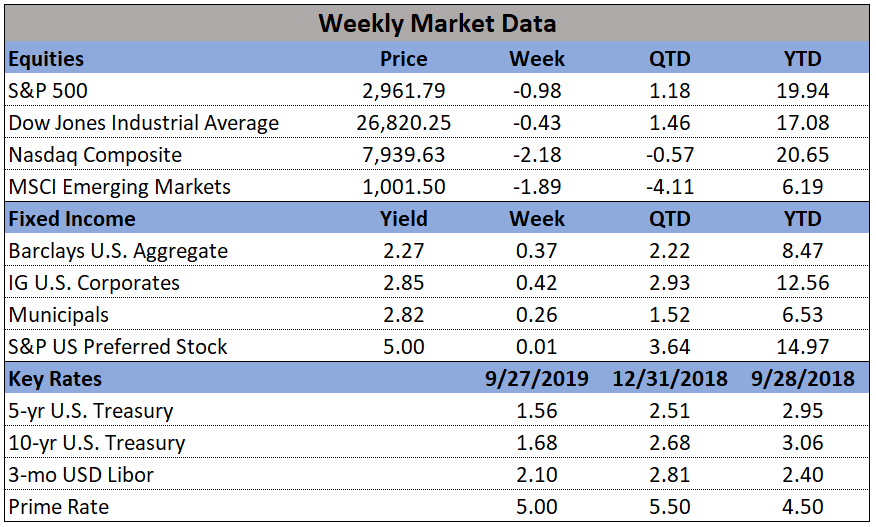Today marks the last day before the Federal Reserve's media blackout leading up to their July meeting. The meeting takes place on the 30th and 31st, and will determine the monetary policy for the third quarter of 2019. Investors are watching this meeting closely, with most expecting a rate cut. But what would this mean for the U.S. economy? And who is the FOMC anyways?
The FOMC
The FOMC, short for the Federal Open Market Committee, is a group within the Federal Reserve that is tasked with determining the monetary policy for the United States. Whenever you hear "The Fed", the "FOMC", or the "Federal Reserve" in investment or stock news, this is the group the author is referring to.
Monetary Policy
Monetary Policy is a set of rules and plans set out by the central bank (the Federal Reserve). These rules control the interest rates and the supply of money within the country's economy. The FOMC uses these two tools to control inflation, spending, saving, and growth.
The Federal Funds Rate
The Federal Funds Rate is the interest rate at which banks loan each other money to maintain their reserves. This is the most basic interest rate, and all other rates are dependent on this one. If the Fed rate goes up, other rates follow (though not immediately). The FOMC uses this rate to change the interest rate environment within the United States. If the Fed worries about high inflation, then they will raise rates, because inflation lowers the real interest rate. For example, if the federal funds rate is 2.5% (as it is now) and inflation is 1.5%, then the real interest rate is 1% (2.5%-1.5%). If inflation were to increase to 2%, then the real rate would decrease to .5%.
If the FOMC worries that the economy is slowing down, or wants to help the economy recover from a recent recession, they will lower rates. This allows banks, and therefore corporations, to borrow at lower rates, improving profit margins and providing more free capital for reinvestment and growth.
Quantitative Easing/Tightening
On top of managing interest rates, the FOMC also manages the money supply within the United States. This is done by buying and selling securities to investors. To reduce the money supply, the FOMC sells government securities (like Treasury bonds) to investors. In this transaction, the FOMC takes the money out of circulation and replaces it with securities. This is Quantitative Tightening (QT). QT increases saving levels and reduces the money available for investment in corporations. In turn, this hampers companies' ability to grow, slowing down an overheating economy. The FOMC reduces the money supply when the economy is doing well.
To increase the money supply, the FOMC uses Quantitative Easing (QE), which is buying government securities. In this transaction, the FOMC takes securities out of circulation and puts money back into the economy. This increases the amount of money for investment in the private sector, stimulating economic growth. The FOMC increases the money supply when the economy is doing poorly.
Why does this matter right now?
I'm sure you have heard about the Fed in the news quite a bit lately, mostly because their actions have been the center of investment news since mid-2018. They are one of only a few government bodies capable of directly impacting the domestic economy, so their decisions carry an incredible amount of weight. Their recent decisions have also caused a fair bit of concern among the investment community.
The FOMC seems to be moving in the opposite direction of their stated operations. As described above, interest rates are usually lowered to stimulate a lagging economy. The economy is currently cranking along, stronger than it has been since before 2008, but the Fed is still hinting at a rate cut. To add to this, the Fed has stopped its Quantitative Tightening initiative, where they were selling the securities that are sinking their balance sheet. From an outside perspective, it seems as though the FOMC is trying to stimulate a failing economy, but the economy is showing no signs of weakness. For now, this is only fueling the expansion. The true damage arises when the economy actually begins to contract.
Where does this leave us?
When the economy contracts, as it inevitably does, the FOMC usually brings its tools to bear against the flagging economy. They decrease interest rates and begin buying government securities to increase the money supply. But as of right now, the FOMC does not have access to either of these tools. With inflation sitting near 2% and the Fed Funds rate at 2.5%, real rates are already almost 0%. Any lower and we risk negative interest rates, where investors are literally paying the government money in order to lend their cash. On top of this, the FOMC owns nearly $4 TRILLION in securities, with only $39 billion in liquid capital. This means the FOMC will be unable to buy securities to increase the money supply.
To conclude, investors are hoping for a rate cut in the coming weeks, but this may not be in the best interest of the economy for the long term. Add in the fact that the markets have priced in a rate cut, and there will be damage no matter what the FOMC decides. At PIR, our short term positions are geared to take advantage of the benefits of the rate cut, but our long term outlook is tempered by the possibility of a steep market decline when the economy finally begins to contract.








